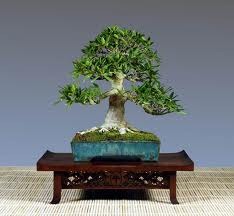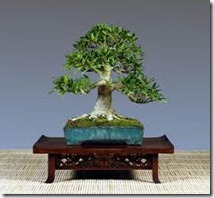A: The exact origins of Bonsai are difficult to determine, but it is generally believed that the art form began in China, and from there spread to Japan.
Trees from the wild were collected from cliff faces and rocky ledges, trees that had naturally been growing in limited amounts of soil. A tree grows differently under such adverse conditions: it grows more slowly, it develops definite bark character, smaller foliage, windswept branches, a rugged aged appearance. A small Bonsai pot imitates those adverse natural conditions.
In simplest terms, a Bonsai is a tree, shrub, tropical plant, grass, or herb, grown in a small container and shaped to recreate an older tree in nature.
Over the years, the Bonsai acquires the character of age. Originally referring to just a "plant in a shallow pot", the term has now come to include the whole art form: growing trees or plants in a dish, with the aim of having it appear as if it had grown that way purely as a result of natural forces, as if the design had happened completely on its own.
Growing a tree in a container, watching it go through the seasonal changes, makes you more aware of the natural world, even if your trees are grown indoors.
And there is never an end to the process: even when you feel the tree is really "finished", you might see it from a different angle, a different view might catch your eye, and you will want to restyle your tree.
Q: Is there a difference in what a traditional Japanese Bonsai Gardener would want and what an American would want?
A: I would say it’s a difference as much as an addition, a whole new aspect. And that is due to the fact that we grow house plants in this country.
Traditionally, Bonsai was an art form geared entirely to the outside, since the trees used for Bonsai were native to their countries and as such needed the climatic conditions of their natural environment. But as interest in Bonsai grew in America, people wanted trees that could be grown inside, in apartments or houses, in addition to the outdoor varieties.
As a result, there has been a lot of interest in varieties that will grow indoors, using not just the traditional trident maples, pines, spruce, plums, wild cherries and other species indigenous to the Orient, but instead using tropical or temperate trees that can be shaped and trained in the traditional styles and still live and thrive in an indoor environment.
Q: How do Bonsai get to look like real trees?
A: Over time, a Bonsai takes on a certain character that comes from being cultivated in a small container. The foliage gradually becomes smaller, and the branching more refined. In other words, the scale becomes more accurately that of a tree in miniature.
The Bonsai gardener should always look at the tree with an eye to how it may be improved to develop more beauty as it ages. This is very likely to involve shaping techniques such as pruning and wiring, something we will be discussing in a later chapter.
Q: How hard is it to grow Bonsai?
A: It’s not very hard at all: there are just a few things you have to understand when you start. The most important thing, the one you can never allow yourself to forget, is that you are dealing with a living tree, that changes and grows, and requires some kind of interaction with you. You need to be in contact with it every day, even if it’s just for a minute or so.
The key to success is checking your tree daily, being careful not to ignore it or to forget about it, just as you wouldn’t forget to brush your teeth or feed your pet.
Most people seem to be attracted to the evergreen. After all, North America is famous for its evergreen forests of fir, redwood, etc. Miniature versions of these forests hold a special attraction. But you may also be drawn to things that don’t really look like they do in nature: maybe your tree will have a large leaf or a large flower that seems to be the essence of the plant itself.
This is one of the aspects that will give it character as a Bonsai, and you may appreciate it as such, even though the leaf is not the right scale for a miniature tree.
Q: Is there a big difference between growing Bonsai and growing house plants?
A: That’s not an easy question to answer, because for either hobby you need some horticultural awareness.
Mainly, I would say, the difference lies in the fact that the plants that are sold as house plants have been hybridized over many years. The goal of the plant industry is to develop individual plants which won’t dry out so fast in indoor conditions, and also will take lower light conditions.
Furthermore, house plants are encouraged to grow and get bigger and bigger, whereas the aim of Bonsai gardeners is to keep the trees very small, or grow bigger only under tightly controlled conditions. Many of the plants used for Bonsai have, generally speaking, not been considered for hybridization at all, and so have not been bred for indoor conditions, though the care and maintenance may be comparable for all plants grown indoors, they are not really the same for both house plants and Bonsai.


Deprecated: strpos(): Passing null to parameter #1 ($haystack) of type string is deprecated in /home/agriviek8Qv/agriviet.net/public_html/wp-includes/comment-template.php on line 2522